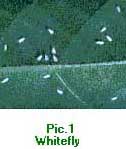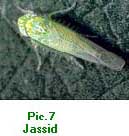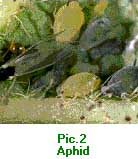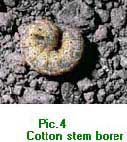Reasons for the squares and boll fall
The growth of the cotton crop is uncertain. During the whole life span of cotton crop the crop bears
numerous square and flowers. But among that very few square forms bolls and we get cotton out of it. Different factors of the climate have its effect on the hybrid varieties of cotton due to which square and boll fall takes place.
Following are the reasons given for boll fall in cotton.
Cloudy weather and shade: Cloudy weather and shade which is seen in some parts of the farm causes square and boll fall.
In farm if more irrigation is given to the cotton crop or heavy rainfall occurs then it dose not allow the water to drain from the soil and due to which square and boll fall takes place.
If application of nitrogenous fertilizers is given in a greater percentage it also causes square and boll fall. Hence farmers should avoid excess use of nitrogenous fertilizers.
In a fertile soil if there is less distance between two plants then due to the availability of less sunlight boll fall may take place. Under such circumstances if the excess of plants are removed it helps to give good yield. The distance between two plants is depend upon fertility of soil, hybrid variety which is grown and rainfall receiving in that particular area etc.
Deficiency of micronutrients also can cause square and bolls fall.
Water stress to the cotton crop causes fall in boll and leaves. Hence crop should be irrigated regularly.
Normally when the crop is at the last stage of growth at that time, leaf and boll drop is seen more. If upper part of 4.5-5.0 ft of height is plucked from the main branch then it also helps to control the drop. The height of the plant, which is to be retained, depends on fertility of soil and variety.
Preventive measures to control the leaf and boll drop
Use of I.A.A: It is seen that use of IAA (Indol acetic acid) helps to control the leaf and boll drop for e.g. when the crop is in flowering stage or after heavy rainfall spraying with IAA should be done so that leaf and boll drop will not take place.
For the availability of micronutrients in the soil, the soil testing should be followed and accordingly fertilization should be given.
If after heavy rainfall the crop is seen light yellow in colour then apply 2% urea alongwith IAA helps to control the drop.
Reasons for the 'unopened bolls' in northern part in case of American cotton
In the northern areas like Punjab, Haryana and Rajasthan it is seen that unopened bolls is a common problem. In which the bolls remain small in size and before its maturity, opening of bolls takes place. In such bolls the available cotton is immature and is of no use. following may be the reasons for unopened bolls.
Scarcity of nitrogen in sandy soil. This type of problem is seen more in salted soil. In which the sodium salt percentage is more in 2-3ft of soil.
In soil (salt containing) the availability of micronutrients like zinc and boron is less and may cause unopenedbolls.
To avoid this use of micronutrients should be done properly along with nitrogen and follow following dose.
Urea - 2% (24m/lit of H2O)
Borax- 0.1% (1gm/lit of H2O) for the deficiency of boron
Planofix- 4.5ml (in 10 lit of H2O)
Zinc sulphate- 0.2% for the deficiency of zinc.
Integrated Pest Management for Cotton
Introduction
India ranks first in acreage and fourth in the production amongst major cotton growing countries viz., Russia, China, India, Brazil, Turkey, Egypt, Mexico and Sudan constituting about 85% of the world's cotton production. Most of the pests in cotton that played havoc in cotton growing states. The cotton bollworm, tobacco caterpillar, whitefly, and jassids are some of the major pests of cotton that have potential to reduce yields by 20-80%. The use of agro chemicals to control the pest is become a pragmatic approach for the pest management. Excessive and in discriminate use of insecticides in cotton has led to problems are insecticide resistance, pest resurgence, accumulation of harmful residues and toxicity to non-target organisms. This has prompted the necessities of integrated pest management approach. Following are the approaches IPM.
Pre sowing
Avoid brinjal
cultivation or sunflower in cotton crop rotation, to reduce the grubs of ash weevil or
whitefly infestations, respectively. Do not stack cotton stalks near fields. Immediately
after the season allow animal grazing in fields and ensure timely removal and destruction
of cotton stubbles, followed by deep ploughing to expose the carry-over population of
bolloworms.
Seed treatment
Destroy the
stalks during off-season to prevent carry over of whitefly. Treat seeds with concentrated
sulphuric acid to kill hibernating larvae and good germination. Treat seeds with Ceresan
wet or Agall 0.1@ 1g/ltr water or treat seeds with Captan or carbendazim @ 2g/kg.
Selection of cultivar
a. For central and south India
Recommended hybrids: NHH-44, PKV HY-2, JK Hy-1, JK Hy-2, H-8, H-10, Ankur-651
Recommendedvarieties: LRA-5166, LRK-5166, LRK-516, PKV-081
Desi types: AKH-4, AKH-8401
b. For North India
Early maturing: F-846, F-1378, LH-1556, F-2054, H-1098,
Recommended hybrids: Omshankar, Fateh, Dhanalaxmi
During sowing
Avoid late sowing to prevent whitefly's flureup and alternate food plants, viz., chillies, lantana
weed, many ornaments if at all in the vicinity. Hybrids must be grown in medium-deep soils
having good drainage. In Central and South India sowing must be completed by the first
week of July. In North India it is preferable to complete sowing operations by the third
week of May. If seed treatment is not given apply 10% granulated phorate @ 10kg/ha at the
time of sowing (1-1.5 gram at each sowing hill) to control the sucking pest at vegetative
growth stage. Grow castor along the border and irrigation channels as indicator or trap
crop for tobacco caterpillar. Castor pollen grains and rich in protein, a good source of
food for natural enemies like lacewing adults, and lady bird beetles.
Management
a. Cultural methods
Immediately after harvest, remove cotton crop and dispose off the residues.
Grow cotton once in a year in the proper season. Avoid ratoon and double the cotton crop.
Use optimal nitrogenous fertilizers and water to check excessive vegetative growth and consequent pest build up.
Avoid malvaceous crops like bhendi, thuththi, oomaththai, tridax poovarasu, etc.
Grow trap crops to reduce the pest intensity.
Acid delinting of cotton seeds with 10ml of commercial concentrated sulphuric acid/kg of fuzzy cotton seeds to kill eggs, larvae and pupae of pink bollworm.
Collect and destroy the larvae collected under the blue cloth spread in the furrows and irrigation channels.
Set up specific pheromone traps at the rate of 12 per hectare e.g. for American bollworm-helilure, pherodin S.L., or spodlure for tobacco budworm and gossyplure for pink bollworm.
Set-up light trap of pheromone trap, 10-12 per hectare to monitor the broad activity of bollworm adults.
Collection of fallen squares, flowers and fruiting bodies and their storage in a caged corner where bollworms do not come out while emerging out due to natural parasitisation.
Collect egg masses of Spodoptera litura, spodoptera exigera or infested shoots with spotted bollworms from cotton as well as caster crop grown on bunds or channels.
Application of NPV in the evening hours 2-3 times at 10-15 days interval @ 450-500 LE/ha reduces the larval population on observing the eggs or larvae of tobacco budworm.
Release of Trichogramma chilonies @ 1.5 lakh eggs per hectare in two installments after 60-75 days of crop age. Against bollworm and other Lepidoterious. These are available as Trichocard.
Release first install larval (50000 per ha) of either Chrysoperla carnea or Mallado boiensis at 15 days interval, to suppress bollworm, white flies, aphids etc. These larvae may be broadcast along with saw dust or along with corrugated papers 1-2 larvae per plant early in the morning.
-
Inductive release of egg-larval parasite Chilonus blackburnii and the predator Chrysoperla carnea, 1,00,000/ha at 6th, 13th, and 14th week after sowing to manage American bollworm.
-
During early stages of square formation, spray endosulfan 200 ml in 500 litres of water /ha. During bolling and maturation stage apply any one of the insecticides phosalone 35 EC 2.5 I/ha.or Quinalphos 25 EC 22.0 1/ha. or Carbaryl 50 WP 2.5 kg (1000 I spray fluid)/ha.
-
Apply N.P.V. followed by synthetic pyrethroid like phosaline or endosulphan, which are less toxic to natural enemies. Pyrethroids should be used only once. Synthetic pyrethroids either as over dose or repeated sprays lead to excessive whitefly flareup.
The control measures for pests of cotton.
| Pest | Economic threshold level for spraying insecticides | Rate of insecticides |
|---|---|---|
| Aphids, Thrips, Jassids, Whitefly | --- | Phorate 10% granulated 10 kg per hectare before sowing (1-1.5gram at each sowing hill) |
| Aphids, Thrips, Jassids | Aphids 15-20% infested plants or adults 10 per leaf, thrips 2 per leaf, jassids 10 per leaf | Spray methyl dematon 8ml or Phosphamidon 2.5ml or dimethoate 30% 10ml or monocrotophos 15ml in 10 litre of water |
| Whitefly | 2-3 per leaf | Spray neem extract 5% or methyl dematon 40ml or monocrotophos 20ml in 10 litre of water |
| Cotton bollworms | 5% or more damaged leaves, flowers, squares etc. | Insecticides for 10 litres of water:- Endosulfan 35% - 20ml or Quinolphos 25% - 20ml or Phenvalrate 20% - 5ml or Cypermethrin 10% - 7.5ml or Cypermethrin 25% - 3ml or Dasis 2.8% - 8ml or Endosulfan 4% dust - 20 kg per hectare |






